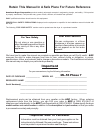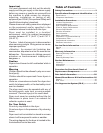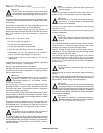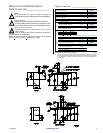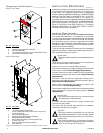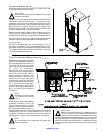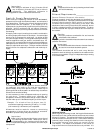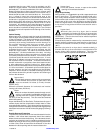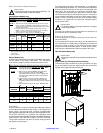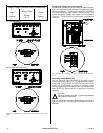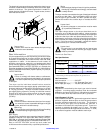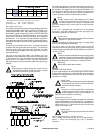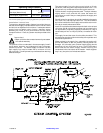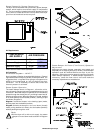
6
American Dryer Corp.
113345-9
! !
!
!
!
Note
Component failure due to dry cleaning solvent fumes
will void the warranty.
Exhaust Requirements _________________
General Exhaust Ductwork Information
Exhaust ductwork should be designed and installed by a
qualified professional. Improperly sized ductwork will create
excessive back pressure which results in slow drying,
increased use of energy, overheating of the dryer, and
shutdown of the burner by the airflow (sail) switches, burner
hi-limits, or basket (tumbler) hi-heat thermostats. The dryer
must be installed with a proper exhaust duct connection to
the outside.
Caution
This dryer produces combustible lint and must be
exhausted to the outdoors.
Improperly sized or installed exhaust ductwork can create a
potential fire hazard.
Important
It is recommended that exhaust or booster fans not
be used in the exhaust ductwork system.
The ductwork should be laid out in such a way that the
ductwork travels as directly as possible to the outdoors with
as few turns as possible. Single or independent dryer venting
is recommended.
Horizontal Venting
When single dryer venting is used, the length of the ductwork
from the dryer to the outside exhaust outlet must not exceed
30 feet (9.1 meters). The minimum diameter of this ductwork
must be at least 8-inches (20.32 cm). In the case of multiple
(common) dryer venting, the distance from the last dryer to
the outside exhaust outlet must not exceed 15 feet
(4.6 meters). The shape of the ductwork is not critical as
long as the minimum cross-sectional area is provided. It is
Important
Even though a minimum of only 12-inches (30.48
cm) is required, 18-inches (45.72 cm) or more is
suggested. The additional clearance is
advantageous for ease of installation and service.
Fresh Air Supply Requirements _______
When the dryer is operating, it draws in room air, heats it,
passes this air through the basket (tumbler), and exhausts it
out of the building. Therefore, the room air must be continually
replenished from the outdoors. If the make-up air is
inadequate, drying time and drying efficiency will be adversely
affected. Ignition problems and sail switch “fluttering”
problems may result, as well as premature motor failure from
overheating.
Air supply (make-up air) must be given careful consideration
to ensure proper performance of each dryer. An unrestricted
source of air is necessary for each dryer. An airflow of 600
cfm (cubic feet per minute [17 cmm] [cubic meters per minute])
must be supplied to each gas, electric, and steam dryer. As
a general rule, an unrestricted air entrance from the outdoors
(atmosphere) of a minimum of 1-1/4 square foot (0.12 square
meters) is required for each dryer. The dryer must be installed
with provisions for adequate combustion and make-up air
supply.
To compensate for the use of registers or louvers used over
the openings, this make-up air must be increased by
approximately thirty-three percent (33%). Make-up air
openings should not be located in an area directly near where
exhaust vents exit the building.
It is not necessary to have a separate make-up air opening
for each dryer. Common make-up air openings are
acceptable. However, they must be set up in such a manner
that the make-up air is distributed equally to all the dryers.
Example: For a bank of four (4) dryers, two (2)
unrestricted openings measuring 2 feet by 1-1/4 feet
(0.61 meters by 0.38 meters) are acceptable.
Allowances must be made for remote or constricting
passageways or where dryers are located at excessive
altitudes or predominantly low pressure areas.
Important
Make-up air must be provided from a source free of
dry cleaning solvent fumes. Make-up air that is
contaminated by dry cleaning solvent fumes will
result in irreparable damage to the motors and other dryer
components.




